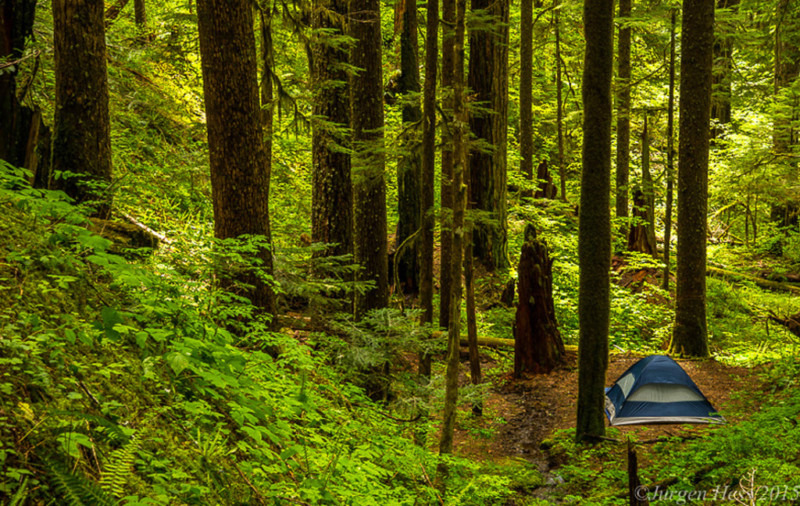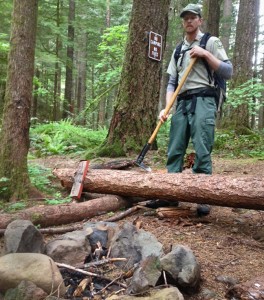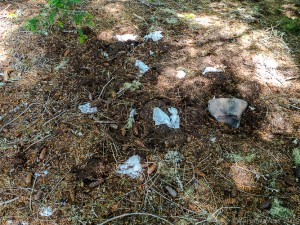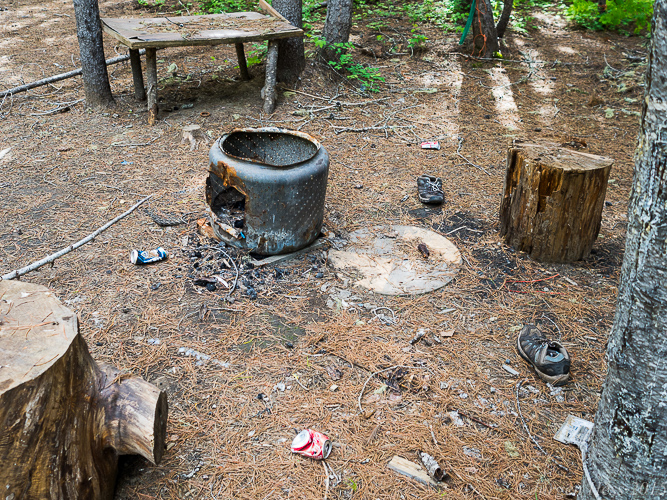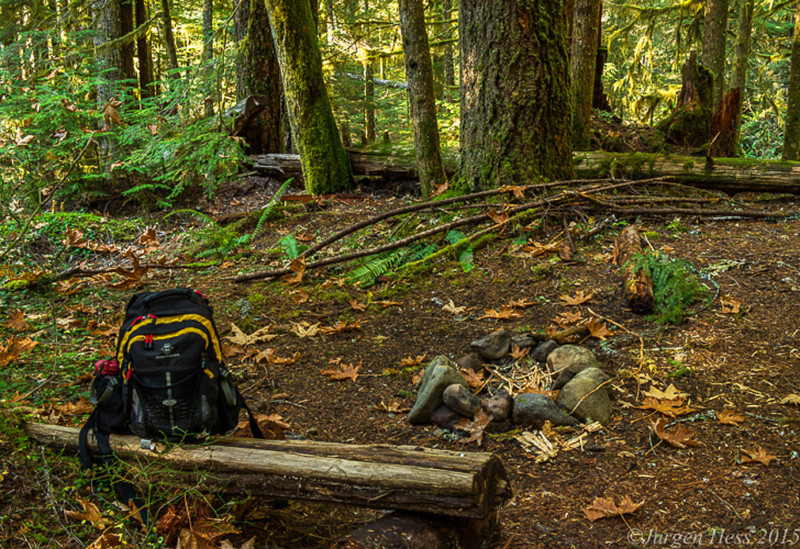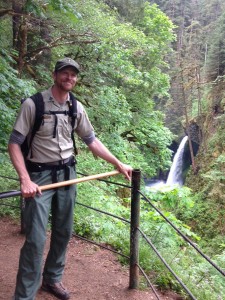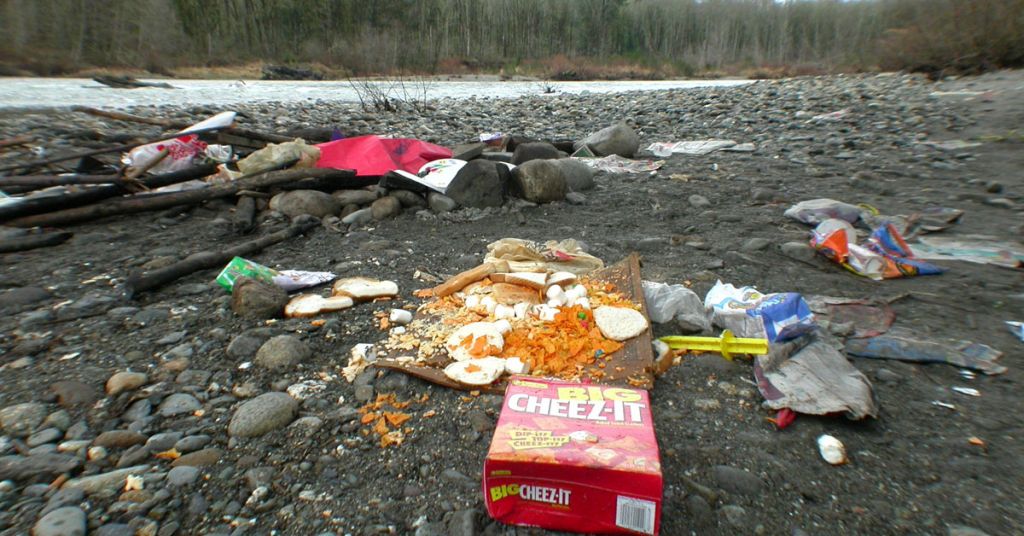By Lynne Davidson. June 27, 2016. ‘No Camping, No Fires’ signs bracket a clearing along Eagle Creek Trail. Yet, on a recent trek, Jonathan Erickson counted eight unauthorized campsites and five illegal fire rings in 70-foot area a mere 30 feet off the trail.
The growing population of the Columbia River Gorge and more importantly the adjacent Portland-Vancouver metro area brings more and more hikers to popular trials like Eagle Creek, hikers who want that wilderness experience. Many stay to camp: some in designated campsites, but others find a place off trail.
What impact does the increasing number of off-trail campsites in the Gorge have on the forest ecosystem?
Is it possible that a seemingly innocuous act as a hiker setting up camp in a forest meadow or secluded woodland causes permanent harm as well?
“Unpermitted campsites are problematic because they destroy vegetation and ruin wildlife habitats,” says Mr. Erickson, Natural Resource Officer of the Columbia River Gorge National Scenic Area. “As the number of people who casually decide to set up camp alongside the trail grows, each additional footprint, each fire, each foray begins to add to the problem of soil compaction.”
The US Forest Service uses a Five-Class Rating System to determine the level of deterioration in a campsite:
Class 1: Ground vegetation compressed temporarily, but not seriously injured.
Class 2: Ground vegetation worn away in immediate vicinity of a campsite.
Class 3: Ground vegetation completely lost in an area, but humus (organic matter) and litter (fallen twigs and leaves) still present
Class 4: Bare mineral soil widespread; tree roots exposed.
Class 5: Soil erosion significant; trees dead or dying.
Hikers impact an ecosystem whenever they pass over established campsites in order to pioneer a new location. Sometimes a newly created campsite is used minimally, thus remaining a class 1 or 2. But more often, Mr. Erickson has seen that these new sites attract subsequent campers, which rapidly deteriorates the site to a class 4 or 5.
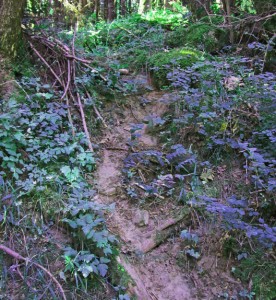 Campers’ boots spawn new footpaths, as they wend their way to water sources and expand their search for firewood, thus continually enlarging the area of destruction.
Campers’ boots spawn new footpaths, as they wend their way to water sources and expand their search for firewood, thus continually enlarging the area of destruction.
“Dispersed camping sites are a complex issue to manage; sites that are used regularly become compacted, killing the mycorrhizae, (fungus) plant roots, and critters that live in the soil,” Mr. Erickson says. “Compact soils are essentially sterilized and lose their ability to regenerate quickly.”
“The creation of new unestablished campsites is a problem we deal with in the Mt. Adams Wilderness area as well,” says Justin Ewer, Wilderness Manager, Mt. Adams Ranger District on the Gifford Pinchot National Forest. “But I would say it is more a symptom of a larger problem: that of people utilizing poor wilderness practices, which adversely impact the resource.”
This rogue trail doesn’t meet standards for drainage, grade, vegetation impact.
For example: the 28 bathroom spots Mr. Erickson found at illegal campsites along Eagle Creek Trail—distinguished by the wads of toilet paper, used feminine hygiene products and unburied human waste clearly visible behind trees and bushes. Besides the eyesore these improvised toilets create are health concerns of parasites infecting a passing hiker or contaminating nearby water sources.
Many outdoor enthusiasts support and practice the Leave No Trace philosophy. “Leave no trace is about more than just ‘leaving only footprints,’” Mr. Erickson says. “Think about where you are leaving those footprints before you step off the trail.” Soil is a living system. As more people venture off-trail, soil becomes compacted and damaged. “In extreme cases, soil compaction can even kill trees,” Mr. Erickson warns.
Naomi Hudetz of White Salmon, WA, is a Triple Crowner, a long-distance hiker who completed the Pacific Crest Trail, the Appalachian Trail and the Continental Divide Trail, thereby hiking 7,900 miles over the past three years. In her months spent on trails, she witnessed novice backpackers initially making inappropriate campsite choices early in their long-distance treks. But as weeks pass, and these backpackers gain experience on the trail, Ms. Hudetz notes, “the backpackers develop a heightened awareness and conscientiousness about choosing campsites that are more aligned with their natural surroundings.”
Left photo: Empty cans, washtub fire pit, forgotten shoes remain at this illegal campsite on the Gifford Pinchot National Forest. Right: A well done hike-in campsite: small space, stone fire pit, clean. Another example is the campsite at beginning of this article.
Perhaps experience in the outdoors is the crucial factor for deepening a respect for the Gorge. Rachel Pawlitz, Community Engagement and Public Affairs Specialist for the U.S. Forest Service observed, “The more time that people can spend outdoors on trails and camping, the more likely they are to become involved with wanting to preserve these wilderness areas where they enjoy recreating.”
“The reality is that creating a new campsite off-trail has the potential to become an established campsite over time, and with the influx of backpackers in the Gorge, campsites are popping up where they never existed before,” laments Tripple Crowner Hudetz.
In addition to the impact that such campsites have on the ecosystem and wildlife habitats, there is a personal element to be considered. In Ms. Hudetz’s experience, “The more human impact that can be seen from the trail, the more it changes the overall wilderness experience for everyone.”
“Humans have got to learn to be more mindful of other species’ homes as they are choosing their campsites,” implores Keith Harding of Parkdale, formerly with the U.S. Forest Service, and a long-time outdoor enthusiast. “Most animals, four-legged and winged don’t carry a great surplus of calories with them for sudden fleeing from well fed humans. It requires an unnecessary expenditure of energy when these animals are forced to relocate their homes because of a camper’s off-trail intrusion.”
While increased foot traffic and illegal campsites have resulted in many harmful repercussions throughout the Gorge, Mr. Erickson says, “Ultimately, at least people are getting out here, connecting with nature, and doing something healthy for their bodies.”
“The trail is all about inclusivity,” concludes Ms. Pawlitz. “It transcends race, class, gender, age. People absorb the value of nature by being immersed in it.”


